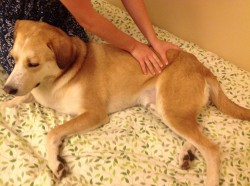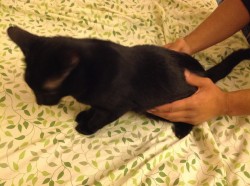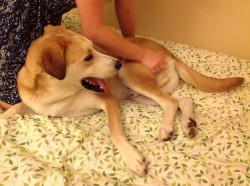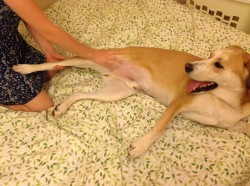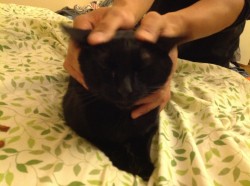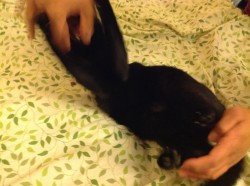Everyone knows how rejuvenating it feels to get a massage. The stresses of daily life and sore muscles can plague not only humans, but animals as well. Massaging your pet can strengthen the bond between pet and owner, aid in finding ticks, fleas, lumps or skin conditions that need treatment, help relieve joint and arthritis pains, develops flexibility, and reduces muscle stiffness and soreness (after a long day at the dog park or run). Dogs are typically fairly easy to massage, but many cats are very sensitive to touch and will need a tailored massage to suit their needs and personality (cats…typical). If you are having issues doing this with either a cat or dog, treats work nicely! Start with a two minute massage and over time you will be able to give your pet longer massages.
How to:
Allow your dog to stand, or get your pet to lie on a flat, comfortable surface.
Start at the head and slowly move your hands gently down the pet’s body, feeling for any stiffness, soreness, or lumps. This will allow you to understand the state of your pet’s health and with time help you quickly find any problem areas, which can help in early prevention of disease or illness.
Again, start to move your hands in slow, methodical circles from the top of head, working your way over the entire body. The circles can be larger for bigger dogs, and much smaller for cats or small dogs. Pay special attention to the area between the shoulder blades as this is where a lot of stress is carried (in both humans and animals). You may even massage your pets feet very gently if they allow you to touch their paws. Always be very gentle and never press down on any bones. If your pet does not like being touched in a certain area (it may be sore or have other issues), use your lightest touch or avoid the area altogether. Any areas that are particularly stiff and do not cause your dog to react unhappily can use some extra tlc, but do not focus on one area for too long as this may inflame the body part more.
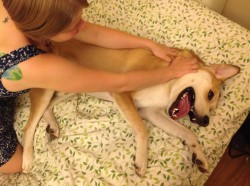
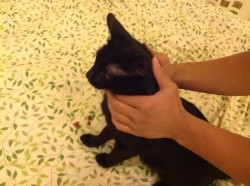
You may “knead” your pets muscles like bread dough (squeezing and lifting), focusing on the neck and shoulders. Take your hands and grasp your pet’s front legs, gently squeezing in an upwards motion from the bottom to the top. Do the same for their back legs, and you can knead their thigh muscles. I like to focus on Hamlet’s back legs because he tends to hold tension there (if standing, he does a little dance, licking the air when I do this!).
If your pet allows it, gently stretch his or her legs, to improve flexibility. This is done by rubbing the area above the joint and slowly starting to rub the joint into an outward stretch (forward for front legs, backward for back legs) I have been doing this to Hamlet for some time and he is extremely flexible! I would also do this to the dog I had growing up (R.I.P. Petey), and it really seemed to help with his arthritic back legs–and I wish I had started doing it sooner.
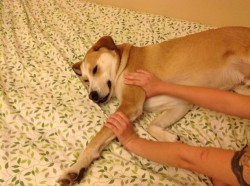
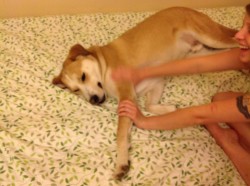 (The face he was making was so funny!)
(The face he was making was so funny!)
While massaging your cat, stroke it’s ears in an outward motion from base to tip. Dogs enjoy a good ear massage as well, but it is especially important for kitties!
Finish the massage with long firm, yet gentle strokes over the body from head to tail. You can even gently squeeze the tail from the bottom to the tip, but do not pull it.
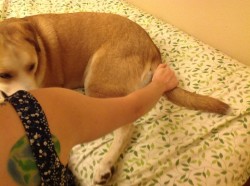
If at any point your pet does something like this:
They’ve had enough and need to stop. You may massage them another day, and they will likely allow you to continue for longer periods of time once they get used to it.
Loki (the cat) is very sensitive to touch and will only put up with a couple minutes of massage, as are many cats–and this can be due to multiple reasons such as: not being socialized at a young age, hyperesthesia, or just plain old playfulness . Hamlet will let you do whatever you want to him, although he has been desensitized to it over time. When I first brought him home from the pound, he was a much different, very frightful dog, and would chew his paws (front and back) when over stimulated. With much patience and work he became the happy go lucky pooch he is today. Each animal is unique and must be respected, and while massaging your pet can help it become more attuned to your touch, you must also be attuned to the moods and needs of the animal you are caring for.
Also by Jessica Ferguson: 8 Tips for Healthy Eating on a Budget
6 Amazing Uses of Diatomaceous Earth
Also in Pets: Lean Mean Green Machine Pet Treat
Introducing Your Cat to the Outdoors
__
Photo: Jessica Ferguson

